Catch of the Day |
||||||||||
 |
 |
|||||||||
DROPS Crocheted Top and Cardigan in Muskat
DROPS 82-6 |
||||||||||
|
TOP: Crochet gauge: 4.5 ch-loops x 10 rows = 10 x 10 cm. Crochet tips for binding off: See diagrams. Front: Ch 91-103-115-127-139. Crochet the first row as follows: 1 sc in 7th ch from hook, * ch 5, skip over 5 ch, 1 sc in the next ch *, repeat from * - * = 15-17-19-21-23 ch-loops, turn the work. Crochet the 2nd row as follows: ch 6, 1 sc in first ch-loop , * ch 5, 1 sc in the next ch-loop *, repeat from * - * across row and turn the work. Repeat 2nd row until the piece measures 15 cm. Now inc 1 loop at each side by crochet 1 extra ch-loop in the next to last ch-loop at each side = 17-19-21-23-25 ch-loops. Armhole: When the piece measures 33-34-35-36-37 cm bind off for armhole as follows: Size S + M: Crochet until last ch-loop, turn the work, sl st to center of 1st ch-loop, continue with ch-loops and repeat bind off at the other side – see diagr 1B. Size L + XL: Follow bind off instructions for size S + M 1 time, turn the piece and crochet back to last ch-loop, turn the work, continue with ch-loops and repeat bind off at the other side – see diagr. 1C. Size XXL: Follow bind off for size S + M: 2 times– see diagr 1D. You have now bound off 2-2-3-3-4 ch-loops at each side = 13-15-15-17-17 ch-loops remain on row. Crochet as before until the piece measures 36-38-40-42-44 cm, then bind off for the neck as follows: 4 ch-loops, turn the work, sl st to center of first ch-loop and continue with ch-loops = 3 ch-loops on shoulder. Continue as before until the piece measures 50-52-54-56-58 cm. Repeat at the other side of neck. Back: Crochet the same as the front. Bind off for armholes as on front. When the piece measures 48-50-52-54-56 cm bind off all sts for the neck by crocheting 2 rows over only 3 ch-loops each shoulder (do not crochet over the center 7-9-9-11-11 ch-loops). The piece measures approx. 50-52-54-56-58 cm, cut yarn. Assembly: Crochet shoulders together as follows: 1 sl st in first ch-loop on back, ch 3, 1 sc in first ch-loop on front, ch 3, 1 sc in the next ch-loop on back, and so on. Crochet sides together in the same manner. Neckband and armhole: Crochet 1 row of hdc around the neck and both armholes as follows: * 1 hdc in sc, 2 hdc in ch-loop *, repeat from * - * and finish with 1 sl st in first hdc on row. CARDIGAN: Sizes: S - M - L - XL - XXL Finished measurements: Bust: 84-94-102-112-120 cm [33" - 37" - 40-1/8" - 44" - 47.25"] Hem: 76-84-94-102-112 cm [29-7/8" - 33" - 37" - 40-1/8" - 44"] Materials: DROPS MUSKAT from Garnstudio 300-350-350-400-450 gr nr 18, white DROPS 4.5 mm [US G] crochet hook, or size needed to obtain correct gauge. 5 DROPS Silver buttons, nr 534 Crochet gauge: 4.5 ch-loops x 10 rows = 10 x 10 cm. Crochet tips for binding off: See the diagrams. Back: Ch 103-115-127-139-151. Crochet the first row as follows: 1 sc in 7th ch from hook, * ch 5, skip over 5 ch, 1 sc in the next ch *, repeat from * - * = 17-19-21-23-25 ch-loops, turn the work. Crochet the next row as follows: ch 6, 1 sc in first ch-loop, * ch 5, 1 sc in the next ch-loop *, repeat from * - * across the row and turn the work. Repeat second row until the piece measures 15 cm, then inc 1 loop at each side by crocheting 1 extra ch-loop in the next to last loop at each side = 19-21-23-25-27 ch-loops. Armholes: When the piece measures 30-31-32-33-34 cm bind off for armholes as follows: Size S: Crochet to last ch-loop, turn the work, continue with ch-loops and repeat bind off at the other side – see diagr 1A. Size M + L: Crochet until last ch-loop, turn the work, sl st to center of 1st ch-loop, continue with ch-loops and repeat bind off at the other side – see diagr 1B. Size XL: Follow bind off for size M + L: 1 time and then bind off for size S: 1 time – see diagr 1C. Size XXL: Follow bind off for size M + L: 2 times– see diagr 1D. You have now bound off 1-2-2-3-4 ch-loops at each side = 17-17-19-19-19 ch-loops remain on row. Continue as before until the piece measures 46-48-50-52-54 cm, then bind off for the neck by crocheting 2 rows over only 4-4-5-5-5 ch-loops for each shoulder (do not crochet over the center 9 ch-loops). The piece measures approx. 48-50-52-54-56 cm, cut yarn. Right front: Ch 55-61-67-73-79, then crochet as on back = 9-10-11-12-13 ch-loops. When the piece measures 15 cm inc 1 ch-loop at the side as on back = 10-11-12-13-14 ch-loops. When the piece measures 30-31-32-33-34 cm bind off for armhole at side as on back = 9-9-10-10-10 ch-loops. When the piece measures 34-36-38-40-42 cm bind off for the neck as follows: Follow armhole bind off on diagr 1D 1 time and diagr 1A 1 time. You have now bound off 5 loops and 4-4-5-5-5 loops remain on shoulder. Continue until the piece measures 48-50-52-54-56 cm, cut yarn. Left front: Crochet the same as the right, reversing shaping. Sleeve: Ch 67-73-73-79-85, then crochet as on Body = 11-12-12-13-14 ch-loops. When the piece measures 6 cm inc by crocheting 1 extra ch-loop in the next to outermost loop at one side, then crochet 5 rows and inc on the other side. Repeat inc at each side 1 time with 5 rows between each inc = 15-16-16-17-18 ch-loops on row. Continue until the piece measures 34-33-31-31-30 cm. Now bind off for sleeve cap by crocheting 6-8-10-10-12 rows with 1 ch-loop less at the end of every row, cut yarn. The piece measures approx. 40-41-41-41-42 cm. Assembly: Crochet together the shoulders as follows: 1 sl st in first ch-loop on back, ch 3, 1 sc in first ch-loop on front, * ch 3, 1 sc in the next ch-loop on back, ch 3, 1 sc in the next ch-loop on front *, repeat * - *. Crochet the sleeve and side seams in the same manner. Then crochet in the sleeves in the same manner. Neckband: Crochet 2 rows sc around the neck – crochet approx. 3 sc in each ch-loop – be sure that the edge is neither too tight nor too loose. Left button band: Crochet 4 rows sc over all sts along left front (incl. over neckband) – crochet approx. 3 sc in each ch-loop = approx. 102-126 sc, turn each row with ch 1. Right button band: Crochet the same as the left, but after the 2nd row make 5 buttonhole evenly spaced along buttonband. The bottom buttonhole should be approx. 10 cm from lower edge and the top one 2 sts from top edge.1 buttonhole = ch 2, skip over 2 sc, 1 sc in the next st. On the next row 2 sc in the ch 2 from previous row. Sew on buttons. |
||||||||||
Diagram explanations |
||||||||||
|
||||||||||
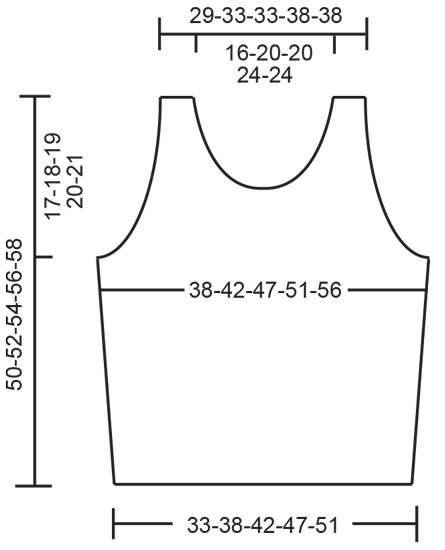
|
||||||||||
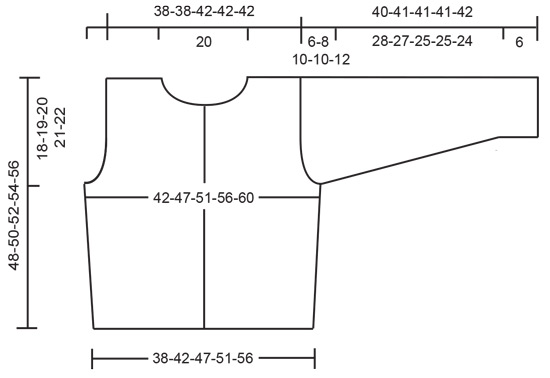
|
||||||||||
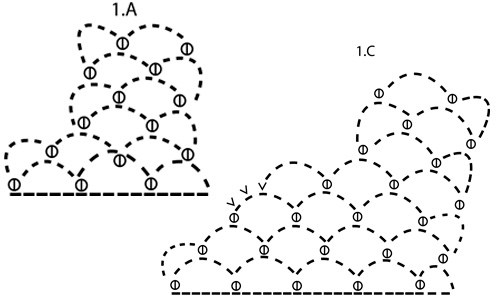
|
||||||||||
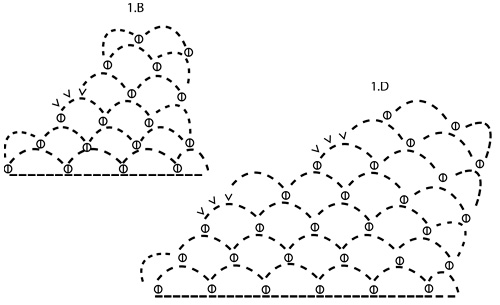
|
||||||||||
|
Have you made this or any other of our designs? Tag your pictures in social media with #dropsdesign so we can see them! Do you need help with this pattern?You'll find tutorial videos, a Comments/Questions area and more by visiting the pattern on garnstudio.com. © 1982-2024 DROPS Design A/S. We reserve all rights. This document, including all its sub-sections, has copyrights. Read more about what you can do with our patterns at the bottom of each pattern on our site. |
||||||||||










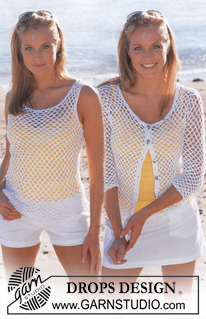




























Comments / Questions (91)
Beste Drops Zou nog antwoord willen geven op mijn laatste vraag van 31 maart?
09.04.2024 - 14:10DROPS Design answered:
Dag Marlies,
Er staan inderdaad geen vasten getekend in 1.A, maar je kunt na het keren van het werk vasten haken tot het midden van het lossenboogje waar het begin van de toer zou moeten zijn. In de teltekening zie je waar de boogjes moeten komen.
09.04.2024 - 20:31Beste Drops, Kan het zijn dat er een fout zit in de Nederlandse vertaling van de afkanting armsgaten vest maat S ? Er staat: Maat S: Haak totdat er nog 1 l-boogje op de nld is, keer het werk en haak hv tot het midden van het eerste l-boogje. Haak door met de l-boogjes en herhaal het afkanten op de ander kant – Zie eventueel teltekening 1A. Er staan echter geen halve vasten op teltekening 1A. De Duitse en Engelse vertaling zijn zonder de halve vasten. Vandaar mijn vraag.
31.03.2024 - 23:53DROPS Design answered:
Dag Marlies,
Toch is het de bedoeling om halve vasten te haken tot het midden van het boogje. (Zo staat het ook in de Engelse en de Noorse versie.)
07.04.2024 - 19:01Er staat het volgende beschreven: De afmetingen op de schematekening kunnen klein lijken, maar de kleding wordt erg elastisch en zal zich ca 5-8 cm rekken in vergelijking met de schematekening. Betekent dit dat de kleding dus 5-8 cm wijder wordt dan op de schema tekening staat?
17.03.2024 - 14:15DROPS Design answered:
Dag Marlies,
Ja, dat klopt inderdaad. Je kan de afmetingen zoals beschreven in het patroon en bij de maattekening aanhouden. Bij het dragen rekt het ietwat uit en komen de maten overeen met standaard confectiematen.
17.03.2024 - 18:59Hejsa. Er det muligt at få at vide hvad opskriften er deleligt med? Prøvede nemlig at hækle den største størrelse, men den var for lille.
09.11.2023 - 21:35DROPS Design answered:
Hej Susan, Hvis du har hæklefastheden som står i opskriften så får du målene som du finder i måleskitsen nederst i opskriften :)
10.11.2023 - 14:39Is there a video on this top?
22.07.2023 - 21:31DROPS Design answered:
Dear Kemba, we don't have a specific video for working this top. You can find all relevant videos for this top in the videos section after the pattern instructions. If you need help with a specific part of the pattern you can always ask here. Happy crocheting!
23.07.2023 - 19:38Jeg forstår simpelthen ikke hvordan diagrammet skal læses. Skal det opfattes om at D1 viser hvordan det skal se ud i både høje og venstre side? Kan i forklare højre forstykke? Skal jeg lave halsrunding i samme side som ærmegabet?
03.07.2023 - 18:15DROPS Design answered:
Hej Charlotte, Halsindtagningen er beskrevet i opskriften på samme måde som ærmegabet og D1 viser hvordan det ser ud i venstre side når du har cardiganen på :)
04.07.2023 - 08:26After crocheting several rows they appear less open than the picture , does the weight of the finished garment help to pull it down and open up the pattern ?
20.06.2023 - 13:58Elizabeth answered:
Sorry folks I’ve answered my previous question by putting sc of next row into the centre chain of the loop and that opens it up perfectly!!
20.06.2023 - 14:25I can't switch from cm to in when I go to the spot to change it. I want it in inches . Any suggestions ?
30.03.2023 - 20:30DROPS Design answered:
Dear Steph, for the measurements in inches, you can take the measurements in cm and input it into the following conversor: https://www.garnstudio.com/conversions.php. If you press convert to inches, the measurement in inches should pop up at the right of the rectangle with the measurement in cm. Happy knitting!
02.04.2023 - 16:54Non tornano le diminuzioni per il top: prima si aumenta di due archi, poi diminuendo di due si dovrebbe avere un totale più alto, invece dice che ci sono 15archi. Qualcosa non va
24.02.2023 - 18:09DROPS Design answered:
Buonasera Monica, dai 19 archi di catenelle si diminuiscono 2 archi per lato arrivando ad un totale di 15 archi di catenelle. Buon lavoro!
02.03.2023 - 19:15Avete un tutorial per seguire le diminuzioni con un lavoro a catenella come questo? Non riesco a capire come eseguire le diminuzioni e a terminare il lavoro. Grazie
24.02.2023 - 18:07DROPS Design answered:
Buonasera Monica, purtroppo non abbiamo tutorial specifici per questo modello. Buon lavoro!
02.03.2023 - 19:11